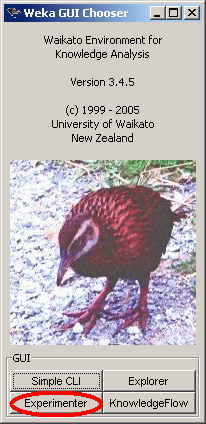

First, you'll have to modify your DatabaseUtils.props file to reflect your database connection.

Reading from Databases is slightly more complicated, but still very easy. For example, the XRFF format saves the class attribute information as wellĭata.setClassIndex(data.numAttributes() - 1) setting class attribute if the data format does not provide this information import .DataSource ĭataSource source = new DataSource("/some/where/data.arff") It can also read CSV files and other formats (basically all file formats that Weka can import via its converters it uses the file extension to determine the associated loader). The DataSource class is not limited to ARFF files. The classifiers and filters always list their options in the Javadoc API ( stable, developer version) specification.Ī comprehensive source of information is the chapter Using the API of the Weka manual. A link to an example class can be found at the end of this page, under the Links section. The following sections explain how to use them in your own code. Attribute selection - removing irrelevant attributes from your data.Evaluating - how good is the classifier/clusterer?.Classifier/Clusterer - built on the processed data.The following suffix will set some parameters of this classifier:Ĭheck the Weka integration Java Docs for more details about the possibilities.The most common components you might want to use are.For example, the following command will run Weka's J48 algorithm on Task 1:.Create a config file called nf in a new directory called.The Command Line interface is useful for running experiments automatically on a server, without using a GUI. You can follow their progress and check for errors on your profile page under 'Runs'. The experiment will be executed and sent to.Go to the "Run" tab, and click on the "Start" button.Add algorithms in the "Algorithm" panel.In the future this search will also be integrated in WEKA. Use the search function on OpenML to find interesting tasks and click the ID icon to list the ID's. Insert the task id's as comma-separated values (e.g., '1,2,3,4,5'). In the 'Tasks' panel, click the 'Add New' button to add new tasks.You can also store this in a config file (see below). Enter your API key in the top field (log in first).You can solve OpenML Tasks in the Weka Experimenter, and automatically upload your experiments to OpenML (or store them locally). From the Tools menu, open the 'OpenML Experimenter'.Select package OpenmlWeka and click install.Open the package manager (Under 'Tools').Launch Weka, or start from commandline:.Download the latest version (3.7.13 or higher).OpenML is available as a weka extension in the package manager: OpenML is integrated in the Weka (Waikato Environment for Knowledge Analysis) Experimenter and the Command Line Interface.


 0 kommentar(er)
0 kommentar(er)
